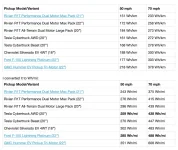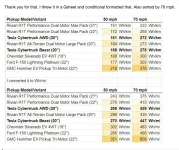I referenced it in another thread, but the Out of Spec range test is now published with numbers.
Dual motor with stock All-Terrain tires. Steady 70-MPH. Zero wind, zero traffic, nearly zero elevation (Austin TX), 45F
100% - 0%: 242 miles
100% - unable to hold 70 MPH: 249 miles
100% - totally dead: 254 miles
More realistically, go from 90%-5%, add in some wind, traffic, a few hard accelerations to merge and this is barely a 200 mile vehicle. And the Tri-Motor “Cyberbeast” version gets even less range.
Let’s just say there’s a reason they came up with this last-minute idea of a range-extender they’ll install in the bed…
In summary, it’s worse than the Lightning (ER Pack) or Rivian and FAR worse than Hummer EV or Silverado EV
Dual motor with stock All-Terrain tires. Steady 70-MPH. Zero wind, zero traffic, nearly zero elevation (Austin TX), 45F
100% - 0%: 242 miles
100% - unable to hold 70 MPH: 249 miles
100% - totally dead: 254 miles
More realistically, go from 90%-5%, add in some wind, traffic, a few hard accelerations to merge and this is barely a 200 mile vehicle. And the Tri-Motor “Cyberbeast” version gets even less range.
Let’s just say there’s a reason they came up with this last-minute idea of a range-extender they’ll install in the bed…
In summary, it’s worse than the Lightning (ER Pack) or Rivian and FAR worse than Hummer EV or Silverado EV
Last edited:


